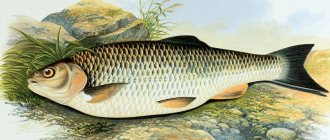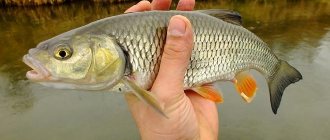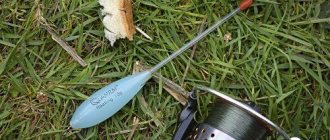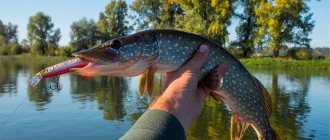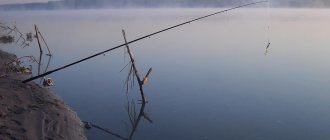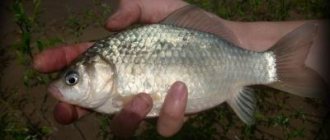Chub is a freshwater fish belonging to the carp family. It has a powerful, elongated body, almost cylindrical in shape, slightly compressed from the sides and gradually tapering towards the rear fin. This shape suggests that the chub is an excellent swimmer and can perfectly withstand fast currents.
The back and sides of the fish are covered with a shimmering golden-pale sheen, and the entire body is covered with large, thick silvery scales. At first glance, the fish is externally vulnerable, but it is well protected by a white chainmail apron from damage, created from hard scales tightly adjacent to each other.
The ventral and anal fins have a distinct red tint. The caudal and dorsal fin are orange in color, while large specimens have a brown color scheme.
The length of the chub reaches 80 cm, and the maximum weight of the fish is 6-8 kg, life expectancy reaches 25 years, it is worth noting that the fish itself grows at a slow pace. For example, at 3 years of age the weight reaches only 200g, and by 6-7 years of age up to 1kg.
Up
Chub spawning
The chub reaches the ability to reproduce at 3-5 years of age. Spawning takes place from April to June, depending on the water temperature; optimal conditions are achieved when the water temperature for reproduction is warmed up at 10-15 degrees.
Large individuals begin to spawn first, choosing rather deep places, and fish of medium and small sizes immediately after them, accordingly stopping in shallower places.
In most cases, the chub does not look for special places for spawning and the female spawns in her usual habitat. In reproduction, the male and female are simultaneously active, and the spawning itself has a mass effect.
In the northern regions, fish like to choose “white nights” for spawning, and in more southern regions, morning hours are chosen for this action.
The caviar has a pronounced orange color, looks like poppy seeds and is quite small. The small size allows the female to be distinguished by fertility, which allows her to lay from 80 to 500 thousand pieces, depending on the size of the fish.
After hatching, the fry, having reached 10-12 cm, begins to feed on small crustaceans and algae, and a little later switches to insect larvae and worms. It is worth noting that for 5 days after the end of spawning, the fish rests, is not active and practically does not feed.
Up
When to catch
What time of day to catch chub? Complex issue. In our practice, the best results were in the morning, but they catch it both during the day and in the evening.
As many authors write, chubs are not caught in winter. Let me tell you, this is not true. You can catch it in winter, for example, with a running donka, or as it is also called, a fool’s donka. By the way, we described in detail the process of fishing with this tackle, read here.
Further we will talk only about chub fishing from spring to September-October.
It is important to note that after spawning (April-June), the chub practically does not bite for about a week or two, and it is very difficult to catch it at this time.
Habitats
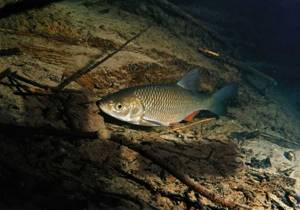
Fish mainly prefer rivers for their habitat, but cases of their appearance in lakes are not excluded. Most of all, this fish population has become widespread in Asia Minor and Europe.
For comfortable habitats, fish prefer fast rivers that have a sufficient number of rapids and riffles. Therefore, chub are often found when there is an acceptable current in medium and small rivers.
At the same time, it loves sandy or hard rocky bottoms and does not tolerate silt and mud. It gives preference to alder trees, vine and blackthroat bushes, which grow along the shore and provide food in the form of insects falling into water bodies.
It often lives in places where there are whirlpools under steep banks, but the chub avoids old riverbeds, bays, creeks and quiet thickets of aquatic vegetation.
Even in the spring, it does not leave the channel into the floodplain, into deep water, but most often goes into tributaries, where spawning occurs. Therefore, a good sign of the presence of this fish nearby is considered to be caught bream, roach, perch, pike and ide.
At the same time, it loves sandy or hard rocky bottoms and does not tolerate silt and mud. It gives preference to alder trees, vine and blackthroat bushes, which grow along the shore and provide food in the form of insects falling into water bodies.
It often lives in places where there are whirlpools under steep banks, but the chub avoids old riverbeds, bays, creeks and quiet thickets of aquatic vegetation.
Up
Selection of spinning baits for chub
The most effective are rotating spoons , which attract the attention of active chub with the noise they create.
When using a spoon on small rivers, use a smaller spoon than on large rivers. In addition, various spinners make it possible to make long casts and work at various, including great depths.
The presence of a wide variety of wobblers makes it possible to optimally select baits that are effectively used when catching chub. In terms of size, the most successful are wobblers with a length of 35 to 65 mm, weighing 3–7 g. In this case, surface and sinking wobblers give good results. However, you need to remember that in each specific situation it is best to choose a successful wobbler through experimentation.
As practice shows, chub prefer dark-colored bait - black or brown. If you don’t have such baits in your arsenal, a black permanent marker can help.
Jig baits (twisters, vibrotails) are also used when catching autumn chub, mainly in late October and November, when the fish goes deeper. Wiring, in this case, must be stepped, and you need to experiment with the length and speed of wiring. The more passive the fish, the slower and calmer the retrieve should be.
The best wobblers for chub - editor's rating and features of popular surface and medium-depth models.
Which line to choose for spinning fishing? Fluorocarbon, braided or monofilament - a detailed description of the advantages of each type of fishing line.
Tying lures with a knotless clasp is a very convenient method.
Chub biting calendar
| January | February | March | April | May | June | July | August | September | October | November | December |
| — | — | + | + | +++ | +++ | +++ | +++ | +++ | + | + | — |
| January | Slight bite in the first half, turning into deep winter at the end of the month |
| February | The chub bites rarely, going into deep places |
| March | As the water warms up, the bite intensifies, and before spawning there is an active feeding |
| April | Best caught in warm small rivers and bays |
| May | Zhor and spring fishing success increases |
| June | The chub is being caught well, the feeding continues |
| July | The bite begins to subside, although the chub feeds intensively |
| August | The intensity of bites occurs quite often and evenly |
| September | The autumn fish catch begins, bottom fishing is used |
| October | As the weather gets colder, biting activity decreases and the fish move deeper |
| November | The chub almost completely settles in the pits |
| December | The fish does not hibernate for long, despite the poor bite, it is possible to catch a large specimen |
Up
What gear should I use?
Chub are caught with small baits; in order to deliver them over long distances, you need a spinning rod with a small dough. Use forms with a minimum bottom test. During wiring, the angler must feel the bait and react to any bite. Select a light spinning rod, 2.10-2.40 long, this will allow you to cast into inconvenient places and not get tired after frequent casting. When catching a bigheaded predator, the most important condition is the weight of the rod. Carbon fiber spinning rods fully comply with this condition. Forms made from this material are lightweight and have a reasonable price.
The chub attacks sharply and powerfully; in the current it is important to hook the fish in time. These conditions are met by rigid spinning rods with a fast action. To fish, you need to adjust the reel's friction and, if you have a good fishing line, you can pull out a chub of any size.
In the fall, you can and should catch chub; if in the summer it is rarely interested in artificial baits, then in the fall you can catch a good trophy using artificial baits.
Finding a fishing spot
In winter: typical places for fish to stay in winter are small rivers with a fairly fast reverse current.
Eg:
Holes after a large roll with a reverse current may conceal the presence not of single individuals, but of a group of well-fed chubs; Small lulls - you may be pleased with the presence of large single specimens;
Extensive return streams near the shore - usually they border near the main stream of the current; often a group of small chubs are stationed in these places.
In spring: fishing spots in the spring will be backwaters, capes, small bays, tributaries, and rivers. You can often observe a flock of chub near the dam outlet, where food appears and the water temperature evens out faster.
In summer: for fishing you need to look for places with good water circulation, confluence points of streams with small rivers, areas with counter and reverse currents behind islands and capes, not far from old bridges. A good place would be an uneven bottom with grassy rifts, snags and stones, and thickets of water lilies.
In autumn: with the autumn cooling, insects begin to gradually disappear and in search of food, fish go to the depths in search of small fish. A more or less normal bite is observed after the water warms up from about 10 am.
Up
Fishing in summer
By the middle to the end of May, when a mass of flying insects appears, the chub begins to peck unstably. During the day, the bite on the catchy morning bait may stop. This period of unstable biting is short-lived; from the end of May - beginning of June, the chub begins to reliably take on grasshoppers and moths. From one to three individuals are placed on the hook, depending on the size.

Alternatively, you can try fishing with blue blowflies . Flies are not suitable as bait when fishing with bottom tackle or fly fishing, as they are easily damaged and knocked off the hook when casting the tackle and hitting the water. Therefore, it is better to fish with a fly using a float tackle or letting the bait go with the flow.
For the second method, a tackle without a float is suitable; the fly is cast smoothly with the supply of fishing line and not far. Next, the bait is allowed to float freely on the surface of the water until a bite follows.
June
It is believed that at the beginning of summer (all of June) the best time for fishing for chub is the early morning from dawn until 7-8 o’clock, as well as the evening from 20 o’clock until sunset and dusk.
In calm, windless weather, when it is hot, fishing during the day can give the best results. In the morning and evening, it is advisable to fish with fly fishing or float gear in the upper layer of water; during the day, fishing from the bottom near holes and riffles is more promising.
You can try to attach the chub in advance . The bait will help if you fish with float or bottom tackle. The bait consists of boiled and crushed shellfish and chopped worms and is placed in places with a not very fast current. The small chub will be the first to approach the bait, and only after half an hour or an hour will the large individuals approach.
July
July is the month when, due to the heat, the chub bite may fade away. During the day, during the heat, the chub walks near the surface of the water, under overhanging plants and refuses to take any bait. Fishing in the early hours and late evening will bring success.
When a massive mayfly emerges, the chub stops taking any other bait and pecks at the mayfly in the upper layer of water.
In August on donka
August is the time when night temperatures drop, and the chub moves to depths where the current is not so strong. In August, fishing with bottom gear using live bait (minnow, goby), shellfish or crayfish is more promising. The hook, just like when fishing from the surface, is done three to four seconds after the pull.
Fishing with live bait will be successful only if you correctly determine the place where the chub stands. During the day, the tackle is cast to deeper places (pits, ledges, deepening riffles), and at night - to shallow places, spits, where the chub comes out to feed after dark.
Fishing methods
Fishing with a rod - used from summer to autumn, the rod must be chosen with medium hardness, a leash with a diameter of 0.12-0.16 mm, and a fishing line with a diameter of 0.14-0.18 mm. After casting into the water, you need to release the line 3.5 meters so that the float floats calmly with the flow, you can twitch slightly, simulating the fall of an insect, which should attract fish.
Fly fishing - the time of emergence of caddis and scum is the best time for fly fishing. The best places for fishing are places with overhanging foliage over trees where insects fall.
Fishing with a spinning rod - you should not take a rod larger than 2.4 m, preferably with a test of 1-10, you can use any artificial bait, the main thing is that its weight should not exceed 8g.
Up
Chub fishing
It should be noted that the chub prefers areas with a confluence, as we have already said, it is especially good if there is a return line, a whirlpool, areas with differences in depth, and whirlpools. The chub can hunt both at depth and in shallower areas x - it all depends on the time of year and conditions, in addition, if bushes grow over the shore, branches overhang - these are potential places where the chub will definitely be, since they can fall off the branches insects and larvae, and when they fall into the water, they immediately become prey for the chub. Knowing these features, you can roughly select the place where you will fish for chub.
Fishing gear
This fish is caught with a variety of gear: most often with a float rod, fly fishing, and a little less often with spinning and bottom gear. At the same time, sometimes a chub can ignore one type of tackle, but bites perfectly on another - you need to know this when going fishing. In our practice, we use float gear (which we sometimes slightly modify during fishing for fishing in currents from the bottom) and spinning rod. You can catch chub from the shore and by wading. The main thing here is something else - the chub is a very cautious fish, so you need to maintain maximum silence when fishing, and at the same time, also disguise yourself: clothes should not be bright, do not approach the shore immediately, but after some time, when the coastal areas have been checked, bend down near the shore, try to hide your presence behind bushes, tree trunks, reeds.
It is very interesting to fish for chub during the summer of the cockchafer. When rigging a rod, there are variations when you can put a light sinker (a couple of pellets), but in some cases fishing can be done without any weight at all: only a hook with a cockchafer and a simple float, which needs to be painted in neutral colors so that it does not particularly contrast with the surroundings environment. The bait is released with the current, it goes ahead of the float, during the fishing process it either sinks slightly or just goes along the surface.
The chub bite is greedy and sharp
Here the general rule applies when fishing in the current: any fish, as a rule, grabs the bait reliably and seriously. Disappearances are rare, and breakage of gear is a much more frequent occurrence, since after hooking the chub resists well, the fish is strong. The question arises, what fishing line to use? If a thicker line (larger diameter) is installed, this can make the tackle coarser, which the chub will not like, but if it bites, you will definitely pull it out. The softer tackle is more catchy, but this requires the fisherman to have the art of fishing so that a break does not occur. So, they fish with a line of 0.15-0.2 mm, but you can use 0.3. Various variations are possible using a leash.
Fly fishing for chub is very beautiful; this is a separate big topic. Alas, there are still few fishermen, for a variety of reasons, who have adopted this gear into their arsenal of methods.
Well, summarizing everything said above, I would like to wish you an excellent bite, and good luck, in particular, in “finding your chub,” experiencing the art and beauty of fishing for this fish, and enjoying the resulting emotions. Good luck to you and all the best.
Share with your friends!
